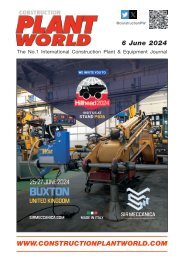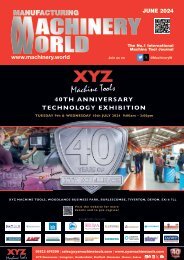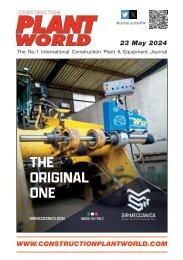Manufacturing Machinery World March 2021
Machinery World was launched in 1982 to serve the machinery & production engineering market. Editorially Machinery World is a news and information source that gives direct contact with the provider of innovative services and equipment. Editorial is available both online and as hard copy.
Machinery World was launched in 1982 to serve the machinery & production engineering market.
Editorially Machinery World is a news and information source that gives direct contact with the provider of innovative services and equipment. Editorial is available both online and as hard copy.
You also want an ePaper? Increase the reach of your titles
YUMPU automatically turns print PDFs into web optimized ePapers that Google loves.
ROBOTICS & AUTOMATION<br />
TÜV SÜD, A GLOBAL PRODUCT TESTING AND<br />
CERTIFICATION ORGANISATION<br />
Functional Safety in a<br />
Digital <strong>World</strong><br />
The increasing connectivity of systems and<br />
plants, plus the growing possibilities of<br />
remote control, has seen a paradigm shift<br />
away from the prevention of access and the<br />
reliable shutdown of machines to the reliable<br />
identification of people and continued<br />
operation. Due to this trend, both possible<br />
damage events and the safety-related parts of<br />
control systems have become more complex.<br />
One example is the introduction of<br />
collaborative operation with robots, where<br />
people and machines work more closely<br />
together and which offers enormous<br />
potential for improving efficiency. Due to<br />
massively increasing system complexity, a<br />
high-quality development and lifecycle<br />
process is therefore required to ensure a low<br />
level of systematic faults.<br />
Despite great technological advances, it is<br />
ultimately organisations and people that<br />
have the responsibility of realising<br />
functionally safe products and systems.<br />
Adequate verification approaches, which<br />
show the effectiveness of safety measures,<br />
must be developed.<br />
Implementation of the many different<br />
requirements of functional safety thus<br />
requires a management framework, which<br />
regulates processes and organisation of the<br />
activities to be performed.<br />
Functional safety management is<br />
therefore a key element of relevant functional<br />
safety standards. This includes the definition<br />
of the roles and tasks of the individuals<br />
involved, proof of their competence, and the<br />
qualification measures necessary to ensure<br />
up-to-date knowledge.<br />
Further elements that must be defined<br />
within the safety life cycle include both the<br />
type and scope of the required<br />
documentation and quality assurance. This<br />
spans the preparation of documented<br />
procedures, work instructions and checklists,<br />
as well as official signature authorisations.<br />
Recording of field experience must also be<br />
regulated, as must modification and<br />
configuration management.<br />
Functional safety management should<br />
also have numerous interfaces with the<br />
higher-level quality management system,<br />
which is typically in place within an<br />
organisation, and which must therefore be<br />
given special attention. It has also proved<br />
good practice to define the responsibilities of<br />
the individual parties clearly and early on in<br />
the quotation phase. This is because<br />
functional safety is not solely the<br />
responsibility of the component or system<br />
supplier alone, but also that of the future<br />
owner of these systems.<br />
Growing digitalisation and automation<br />
across all areas of life and industry not only<br />
increases the significance of functional safety,<br />
it also offers economic opportunities. Safe<br />
product design, early prevention of<br />
conformity-related problems, fewer product<br />
recalls, and shorter time to market are just<br />
some examples. Manufacturers and owners<br />
can therefore exploit these opportunities by<br />
establishing a systematic process focus. This<br />
should include consideration of the entire<br />
system life cycle, at an early stage - ideally in<br />
the development phase.<br />
To mitigate against systematic faults, the<br />
effectiveness of safety measures must also be<br />
fully verified. This will confirm the<br />
robustness of components, as well as the<br />
complete life cycle, and the development<br />
process must also be considered during such<br />
an assessment. A holistic approach to<br />
functional safety is therefore required, which<br />
requires expertise in various application<br />
fields across all project phases, from design<br />
and development to manufacturing and<br />
installation, testing, certification, placing into<br />
service, and decommissioning. Given this<br />
complexity, testing and certification<br />
organisations need to provide holistic<br />
services, which offer system owners and<br />
manufacturers one-stop multi-disciplinary<br />
support.<br />
www.tuvsud.com/uk<br />
22 <strong>Manufacturing</strong> <strong>Machinery</strong> <strong>World</strong>, <strong>March</strong> <strong>2021</strong>


















